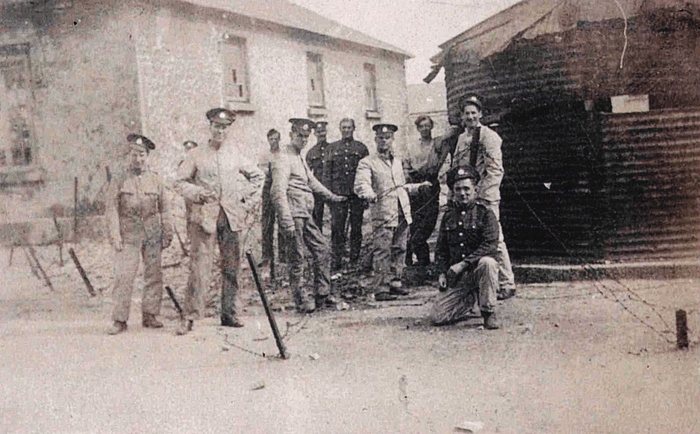The last months of 1920, were the most vicious and bloody in the War of Independence in Galway. There were a lot of killings, burnings, shootings and beatings.
There was a sweeping round-up of hundreds of the usual suspects and the old gaol in Galway could not take any more prisoners. Two internment camps were opened in the city, one in the military camp on Earl’s Island where prisoner John Costello described his experiences as, “33 of us were given 32 blankets and herded into an old hut without glass in the only window, and never got a cup, knife or fork during our 13 days.”
These prisoners were eventually moved into the Town Hall Theatre which was commandeered as the second internment camp.
Let out only to 'shake the lice from their blankets'
Geraldine Plunkett Dillon wrote that “The Town Hall was filled with men prisoners, 134 of them, night and day without exercise or air, means of washing or getting rid of vermin, without enough to eat or any quiet or privacy …. One officer used to let them out once a week to shake the lice out of their blankets, but this was stopped on account of an epidemic of mumps among the prisoners which occurred on December 30, 1920."
Those with the sickness were moved to the Isolation Hospital on Lough Atalia.
'We were caged monkeys from a zoo'
Patrick Tunney from Westport, described the conditions in the Hall as, “All prisoners slept on the boarded floor of the building, and with two bags each, we considered it fair enough. We had, for exercise, the open square which lay between the halls. The place was rendered secure with tons of barbed wire entanglement, through which the civilian population of the city often gleked derisively and scornfully as if we were caged monkeys from a zoo. Being a garrison city, the majority of the residents at that time were rather hostile to all Republican elements”.
'Some passers-by used to throw food parcels over the barbed wire'
Not all the residents were hostile. Because the detainees were so badly fed, many of the shop assistants in town gave a shilling from their wages each week which paid for a hamper of food. The money was collected from the various premises and given to Bid McHugh who prepared the food and when the cash was not enough, she made up the balance herself. Some passers-by used to throw food parcels over the barbed wire to those waiting on the other side.
Conditions inside were filthy and smelly, there was an awful lot of noise and occasional ill-treatment of the prisoners. The only exercise was to walk as best as one could, through the crowd around the large room. Every three days, the prisoners were escorted outside to walk, but the ground was often muddy, and the mud carried in on their boots just added to the general filth. Up to forty men were lying on the stage.
They were guarded by the Sherwood Foresters, some of whom were kind to the prisoners. One used to run messages for them. One officer however continually showed his contempt for the prisoners and mocked them whenever he could. This was almost certainly Captain Harrison, who went so far as to install a dictaphone in the tiny confessional under the stairs. When it was discovered, they made smithereens of it. Nothing was ever said.
Influenza
Michael Mullin from Annaghmore, Mountbellew had been arrested on November 28, 1920 and ended up in the Town Hall. He was in the best of health until December 29, when he became ill.
Just two days prior, he had been playing football in the hall with other internees. On becoming ill, he was attended by the only prisoner who was a doctor, Dr Heneghan from Ballindine, who pronounced him dead on January 3, 1921. The cause of death according to the doctor being meningitis. On the same day, another prisoner, Patrick Walsh from Hollymount, County Mayo also died.
The authorities said the cause was influenza. A contemporary report said, “It is far from clear what the actual cause of death was in both cases, with the coroner’s report hastily published with little detail of explanation”. Their fellow prisoners claimed that both had suffered beatings in the camp and both had become ill soon after and died.

British soldiers dismantling the internment camp site
Demanding better conditions
The deaths frightened the authorities, doctors were demanding more space for the internees and they be allowed more fresh air. So, the army took possession of St Nicholas’ Parochial School and some prisoners moved there; others were moved to the County Gaol and also to Earl’s Island.
We have two photographs today, the first (courtesy of the National Museum ) showing a group of prisoners behind the barbed wire and the other (above ) showing British soldiers starting to dismantle the site.
This week, the Town Hall have erected and enlarged copy of the first image, together with an accompanying text, as a memorial to the two republicans who lost their lives on the premises. It will be on permanent exhibition there.
Next year, the Town Hall will celebrate a notable anniversary, they will be two hundred years old.
If you have any stories, memories, old posters, photographs, memorabilia relating to the building, would you please contact, Fergal McGrath at the theatre. His email address is [email protected] and the phone number is 091 569777.

